


Crux Australis Herald
Baron Uberto Renaldi [mka Nigel Castle]
GPO Box 2719, Adelaide SA 5001, Australia
phone: (08) 8336 6791 or intl +61 8 8336 6791
 |
Crux Australis Herald
|
"The CAMeL" Unto the College of Heralds of the Principality of Lochac, and all others who may read this missive, from Baron Uberto Renaldi, Crux Australis Herald, greetings! In this issue...
Last chance to be my successor... | Reports | Position still vacant - Baryl Pursuivant
A plea from the First Coronation steward | Submissions guidelines updated
Roster changes | Important addresses | Subscriptions and Resources | Submission requirements
Meeting schedule | Submissions from March | Submissions from April | News of previous submissions
The March & April 2002 (Anno Societatis XXXVI) Bumper Issue!
Thanks from Festival Thanks to the work of many, the heraldry at Festival and Crown Tourney went very smoothly this year. My sincere thanks go to everyone who gave up some of their time to assist; I won't name you all because I'm sure there will be some I miss (and this CAMeL is long enough as it is) but I will pick out a few for special mention.
Karl Faustas von Aachen for being 'sinister chief' herald of the event and the 'spider in the web' in coordinating the voice heraldry for Crown Tourney and Fighter Auction Tourney, Giles of Leabrook for handling most of Their Majesties' courts, and John Theophilus & Jade of Starfall (both from the central West) for their guidance and experience.
I have but two complaints: one is the dearth of 'campsite heralds' to make regular announcements at their nominated campsite (calls for volunteers for this was not in the info pack, so I forgive you all), the other is the inability of the Crown Tourney field heralds to use up all of the tab I placed on the bar for them! Sigh...
Your servant,
Baron Uberto Renaldi,

Crux Australis Herald
Last chance to be my successor
You still have until 3rd May 2002 to apply to be Lochac's first Principal Herald. The duties and requirements of the office are here.End-of-Reign reports from ALL group heralds are due by 8 June 2002. My successor will no doubt be using these reports to gain an insight into the state of heraldry when they step up, so it is imperative that you provide a full and accurate report.
As a reminder, here's what ideally should go into your reports:
Position still vacant - Baryl Pursuivant
The position of Baryl, as external commenter for Lochac, is still vacant. I have so far received no expressions of interest.
The job involves producing a "Letter of Comment" at least every other month, in which submissions recently forwarded to the College of Arms for registration by other kingdoms are commented upon. Requirements for the office are: a good working knowledge of the Rules for Submissions and the Administrative Handbook, access to e-mail and access to suitable reference books and the SCA Armorial and Ordinary. Having a friendly group of local heralds (and wannabe's) to assist you is also useful (to you and them).
If you are interested let me know and I will arrange to have some Letters of Intent and Letters of Comment sent to you so you can see what you are expected to produce.
I am quite keen to have commenting being done in as many groups as possible, with Baryl being the coordinator and possibly collating the results into their Letters of Comment. Commentary meetings are an excellent way to improve book heraldry at all levels and to keep in touch with what the rest of the Society is doing in this area. Contact me if you’d like more information.
A plea from the First Coronation steward
Mistress Kiriel du Papillon has written to me requesting the support of the College of Heralds in helping to run what will undoubtedly be one of Lochac’s largest indoor events on July 6th-7th.
Therefore, I am calling for volunteers to assist with field work for the rapier tourney on Saturday and the heavy tourney on the Sunday, duty work for both days and the many hours of courts on the Saturday. Please contact me by mid-June with your preferences and I will have your name added to the duty roster.
The eyes of the Known World will be on Lochac for this event. Our participation is crucial for its success, so I expect all rostered heralds in attendance to volunteer some of their time (it’s part of your duties and responsibilities, remember?). If you are present and a rostered herald and don’t volunteer, you’d better have a very good reason why, because I will be asking!
Submissions guidelines updated
It was pointed out to me recently that the guidelines for filling in the submission forms were a bit vague in some areas and inaccurate in others. Therefore, I have done a major revision of them which can be found here on the Crux Australis website.
If you assist anyone as their consulting herald then please provide this information to them and take the time to answer any questions they may have. Anything you can't answer should be forwarded to me or Mortar Pursuivant.
Giovannino di Vidor has been rostered as Acting Frette Rouge Pursuivant in Innilgard.
Wakeline de Foxley, having attended too many monthly submission meetings and revealed too much knowledge of armory (especially in his excellent conflict-checking), has finally been rostered as a Pursuivant Extraordinary At Large.
Crux Australis Herald: Uberto Renaldi [Nigel Castle] GPO Box 2719, Adelaide SA 5001. Ph (08) 8336 6791. Email herald@sca.org.au
Hund Herald (West Kingdom external commentary) and Bombard Pursuivant (Ceremonies deputy): Thorfinn Hrolfsson [Steven Roylance] 1592 Malvern Road, Glen Iris VIC 3146. Email roylance@corplink.com.au
Canon Pursuivant (Precedence and Gentry list): ): Morag Freyser [Helen Brinsmead] PO Box 455, Woden ACT 2606. Email canon@sca.org.au
Mortar Pursuivant (Education and Training): Massaria da Cortona [Melanie Johnston-Hollitt]. Email: massaria@hotmail.com
Rocket Pursuivant (New PE test): Aislinn de Valence [Megan Dansie] PO Box 526, Unley SA 5061. Email aislinn@merlin.net.au
Baryl Pursuivant (External commentary): VACANT- PLEASE APPLY
Subscriptions and Resources
"The CAMeL" is available from Crux Australis at $20 per year. Make cheques payable to "SCA Inc. College of Heralds".
Laurel's Letter of Acceptance and Return is available from the SCA College of Arms. Send a cheque for $US25 made out to "SCA Inc. - College of Arms" to Bruce R. Nevins, 2527 E. 3rd Street, Tucson AZ, 85716-4114, USA. As usual, everything of relevance to Lochac will be published in "The CAMeL".
The Armorial and Ordinary, as well as updates to them, are available from SCA Inc. - Free Trumpet Press West. Their address is '1613 N. School St., Normal IL 61761-1240, USA'. They also sell the "Heraldic Pictorial Dictionary for the SCA", proceedings of Known World Heraldic Symposia and Compilations of Precedents by past Laurel Sovereigns of Arms. Contact me or visit their web site for more details.
I also recommend that groups acquire some name resources, in particular P.H. Reaney & R.M. Wilson's "A Dictionary of English Surnames" and E.G. Withycombe's "The Oxford Dictionary of English Christian Names". The latter is currently out of print, so if you spot it at a second-hand book sale, buy it!
Useful or interesting links:
The Blazons mailing list, the email list for Lochac's heralds - www.sca.org.au/mailman/listinfo/blazons.
The SCA Heraldry web page - www.sca.org/heraldry including the Laurel home page and on-line armorial and ordinary search.
The Academy of Saint Gabriel (lots of good articles on medieval names) - www.s-gabriel.org
West Kingdom Heralds' Handbook - heralds.westkingdom.org
Free Trumpet Press West (SCA heraldic publications) - www.sca.org/heraldry/ftpw.
Parker's Glossary of Heraldry - http://www04.u-page.so-net.ne.jp/ta2/saitou/ie401
Cost: $20 per new submission (name, device or badge). Note: a new name and device costs a total of $40. No cost for resubmissions or branch submissions. Make cheques or money orders payable to "SCA Inc. College of Heralds". Do not send cash through the post!
Copies required:
Please include ALL necessary documentation to support each submission. It is the responsibility of the submittor to present their submission in a way that makes registration easy. Name documentation should be as accurate as possible: remember to include photocopies of the title page as well as the relevent page(s) of any source used.
Crux Australis submission meetings are usually held once a month at 36 Rosella Street, Payneham SA. Please call beforehand if you intend to bring submissions for processing. The next meeting is scheduled for 2pm, Sunday 12th May 2002. The final meeting over which I will preside as Crux Australis is tentatively scheduled for 16th June (probably followed by much merriment and the consumption of alcohol and fatty foods).
Present at the Crux Australis Submissions Meeting held on Sunday 10th March 2002 at 36 Rosella Street, Payneham SA were: Uberto Renaldi, Crux Australis Herald; Massaria da Cortona, Mortar Pursuivant; Gruffydd ab Ieuan ab Cynan and Wakeline de Foxley, Pursuivants Extraordinary At Large; and interested onlooker Magdalena di Franco.
The following submissions were FORWARDED to the College of Arms in March 2002 for registration:
Change of Registered Name
The submittor’s name current name of Caterina Ruzzini was registered in January 1998. She desires a 15th-16th century feminine Spanish or Catalan name and cares most about the language/culture.
This was originally submitted to Crux Australis as Catalina Ximena Villanova de Santa Maria del Cami. Although the submittor has allowed minor changes only, she has agreed to drop del Cami if it's inclusion would otherwise make the name unregistrable.
Catalina: Julia Smith. 'Spanish Names from the Late 15th Century' cites this as being the third most popular feminine name in the late 15th century household accounts used to compile her list of Spanish names of that period.
Ximena: Francisca Arana de Love, 'Nombres Propios Españoles' (Editorial Vosgos, 1982), s.n. Jimena, has this as a 'variante arcaica' of Jimena. No date is given, but advice received from Julia Smith [aka Juliana de Luna] via email is that this name was popular before and after the submittor's era of preference but not during it. The submittor is aware of this but still wishes to use the element anyway.
Villanova: Julia Smith. 'Spanish Names from the Late 15th Century' cites this as a late 15th century Spanish locative byname.
Santa Maria del Cami: this, according to the website http://www.illes.net/smariaes.htm is a town in Mallorca dating back to at least 1247 (or at least the church there does). Smith gives Santa Maria as a late 15th century Spanish locative byname.
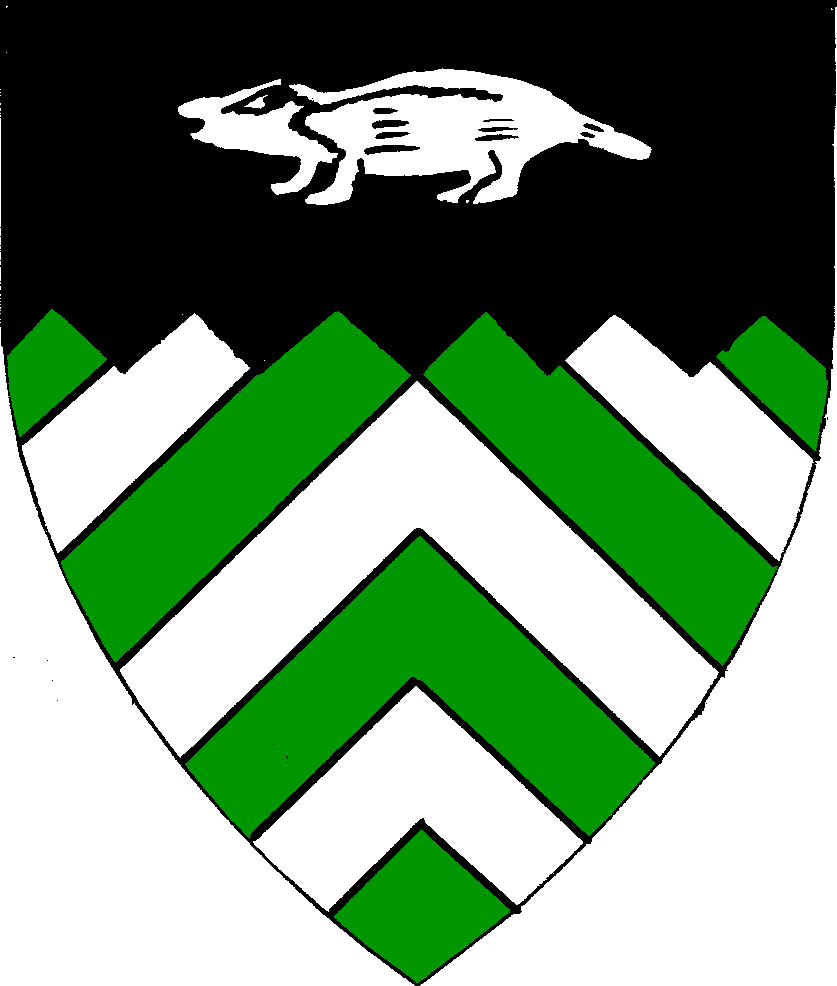
New Name and Device
Chevronelly vert and argent, on a chief indented sable a badger statant argent.
The submittor desires a masculine 14th-15th century 'Byzantine' (Greek?) name. He will accept minor changes only, but will allow Rossos to be dropped and the Vigilant to be translated to it's Greek equivalent if either or both of these changes are necessary for registration.
Dareois: According to a letter from the Academy of Saint Gabriel (client #2233), Dareios is a Greek adaptation of the name of a Persian king, and appears in the Old Testament. Dario was in use in Crete in the 15th century, though mainly by Italians, so it is theoretically possible that it was known (in the form Dareios) to 15th century Greeks.
Rossos: According to a letter from the Academy of Saint Gabriel (client #2233), this is a Greek epithet meaning 'the Russian', and is similar to the late Byantine epithets Slavos "Slav" and Alvanites "Albanian".
the Vigilant: Reaney ('A Dictionary of English Surnames'. Revised 2nd edition. Routledge London 1979) does not list Vigilant as an English surname, but the submittor argues that it is no more abstract than 'le Téméraire' (French for 'the Bold') that was used as an eptithet for a 15th century Duke of Burgundy (although no evidence was presented to show that this was used of him in his lifetime). According to the Oxford Learner's English/Greek Pocket Dictionary, the equivalent word in modern Greek is agrupnos. As to whether or not agrupnos (or an earlier variant) is an appropriate epithet, we must rely on advice from anyone in the College of Arms who knows something about Greek names and who wishes to enlighten us.
New Name
The submittor desires a feminine 16th century Venetian name, cares about the sound and the language/culture, and will accept major changes.
Magdelena: Jo Lori Drake, 'Italian Renaissance Women's Names' gives this in a list of Italian Renaissance women's names compiled from 'The Society of Renaissance Florence' and 'The Autobiography of Benevenuto Cellini'.
di Franco: Josh Mittleman & Brian Scott, 'Fourteenth Century Venetian Personal Names' give Cecilia di Franco in their examples of Venetian names of the 14th century.
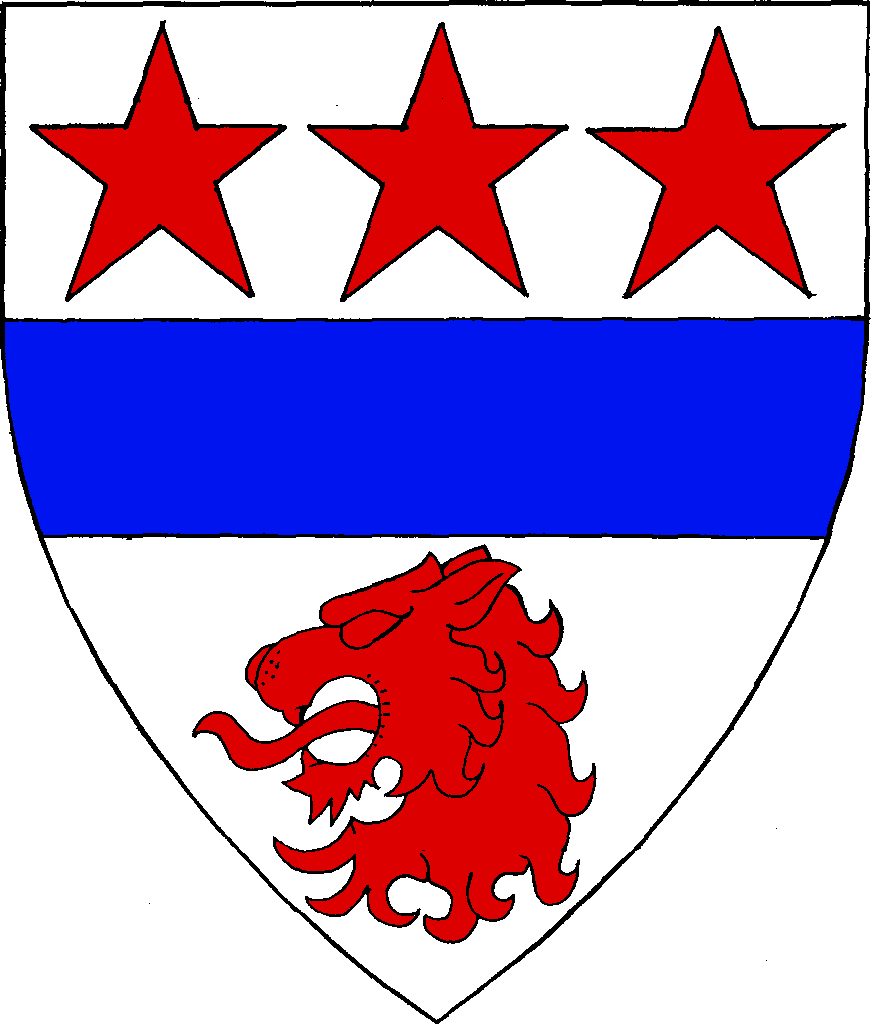
Device Resubmission to Laurel
Argent, a fess azure between three mullets and a lion’s head erased gules.
This gentle’s name was registered in April 2000. His last submission to Laurel, Sable a lion’s head erased argent langued gules was returned in the same month for conflict.
The following submissions were RETURNED in March 2002 for further work
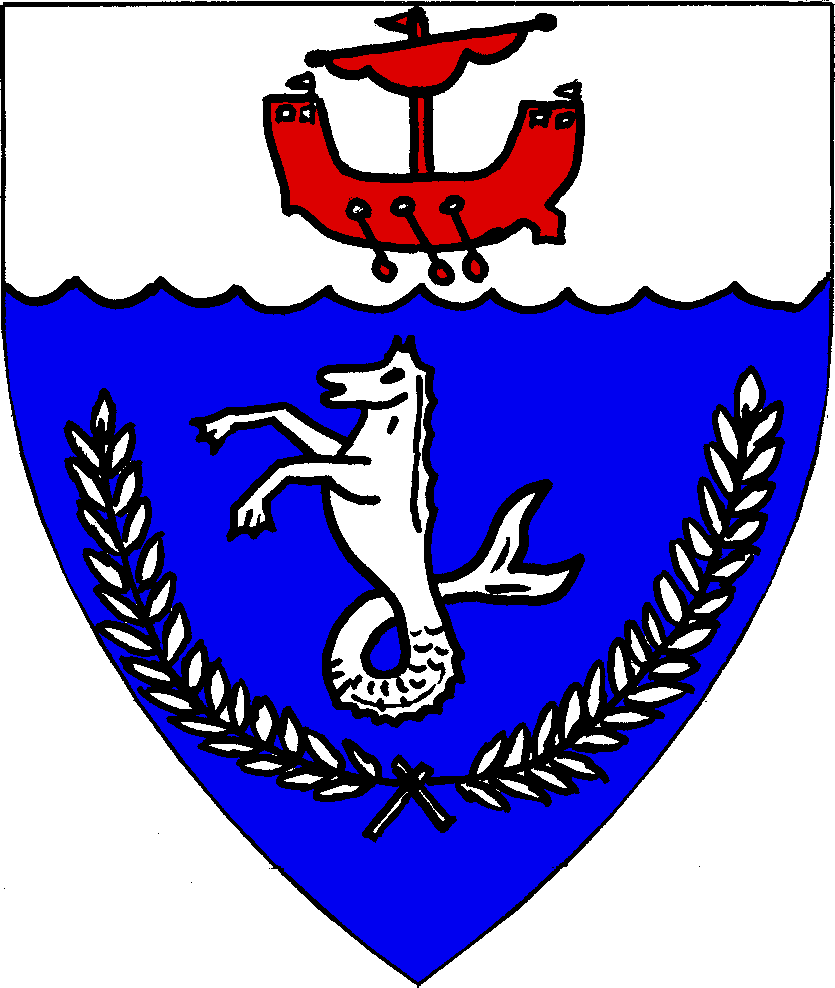
Device Resubmission to Laurel
Azure, a seahorse erect withing a laurel wreath and on a chief invected argent a lymphad gules.
This has been returned for redrawing. The laurel wreath needs to be wreath-shaped, that is: circular.
Also, the chief needs larger and fewer indentations.

New Branch Name and Device
Per fess embattled vert and sable, a demi-sun issuant from the line of division and a laurel wreath argent.
This name is probably in conflict with the real placename Stow on the Wold in Gloucestershire, England.
The Administrative Handbook, section III.A - Protected Names states:
5. Names of Significant Geographical Locations Outside the Society - A geographical location will be considered significant if it is associated with important administrative, social, political or military events (e.g., a capital city, the site of a major treaty or battle, etc.)...
Although Stow is very common in English placenames, Stow on the Wold appears to be unique, and is historically significant as the location of the last armed conflict of the English civil war, in 1646. A search of the World Wide Web using GoogleTM returned over 12,000 pages that feature the name, and the town appears to be a major tourist attraction. Everyone at the meeting had heard of it.
Therefore, even though the town does not appear to have it's own entry in any generic encyclopædia we consulted, we felt that Laurel would be very likely to consider the real Stow on the Wold significant enough to protect. The populace of the Canton may disagree, of course, and we will welcome any valid appeal that they may subsequently submit.
The device also had to be returned, for redrawing. The demi-sun depicted here is too large - it effectively makes the charge unidentifiable and instead gives the impression of Per fess embattled argent and sable with a very strange chief vert. The laurel wreath also needs to be drawn a bit larger.
Present at the Crux Australis Submissions Meeting held on Sunday 14th April 2002 at 36 Rosella Street, Payneham SA were: Uberto Renaldi, Crux Australis Herald; Massaria da Cortona, Mortar Pursuivant; Giovannino di Vidor, Acting Frette Rouge Pursuivant; William Forester de Blackwode, Pursuivant at Large; Wakeline de Foxley, Pursuivant Extraordinary At Large; and heralds-in-training Lendl, Laufey rau{dh}refr and Magdalena di Franco.
The following submissions were FORWARDED to the College of Arms in April 2002 for registration:
New Name (see RETURNS for Device
The submittor desires a feminine name of unspecified (presumably English) origin, cares most about the sound and will accept major changes.
Eleanor: this spelling (as well as Alienor and Elianor) was in use from the 12th to the 15th centuries [E.G. Withycombe, 'The Oxford Dictionary of English Christian Names', 3rd ed.].
Orkney: Orkney is the largest island in a small archipelago to the north of Scotland. The Anglo-Saxon Chronicle makes reference to Orkney in 47AD, when the isle was conquered by Claudius, and in 1066 (Worcester manuscript) where an Earl of Orkney is mentioned. There is also the 13th century Icelandic Orkneyinga saga, an account of the Norse earls (jarls) of Orkney. The byname originally submitted was 'of the Orkneys' but we have no evidence to show that this plural form was used in period (although Ptolomy did refer to this group of islands as Orcades).
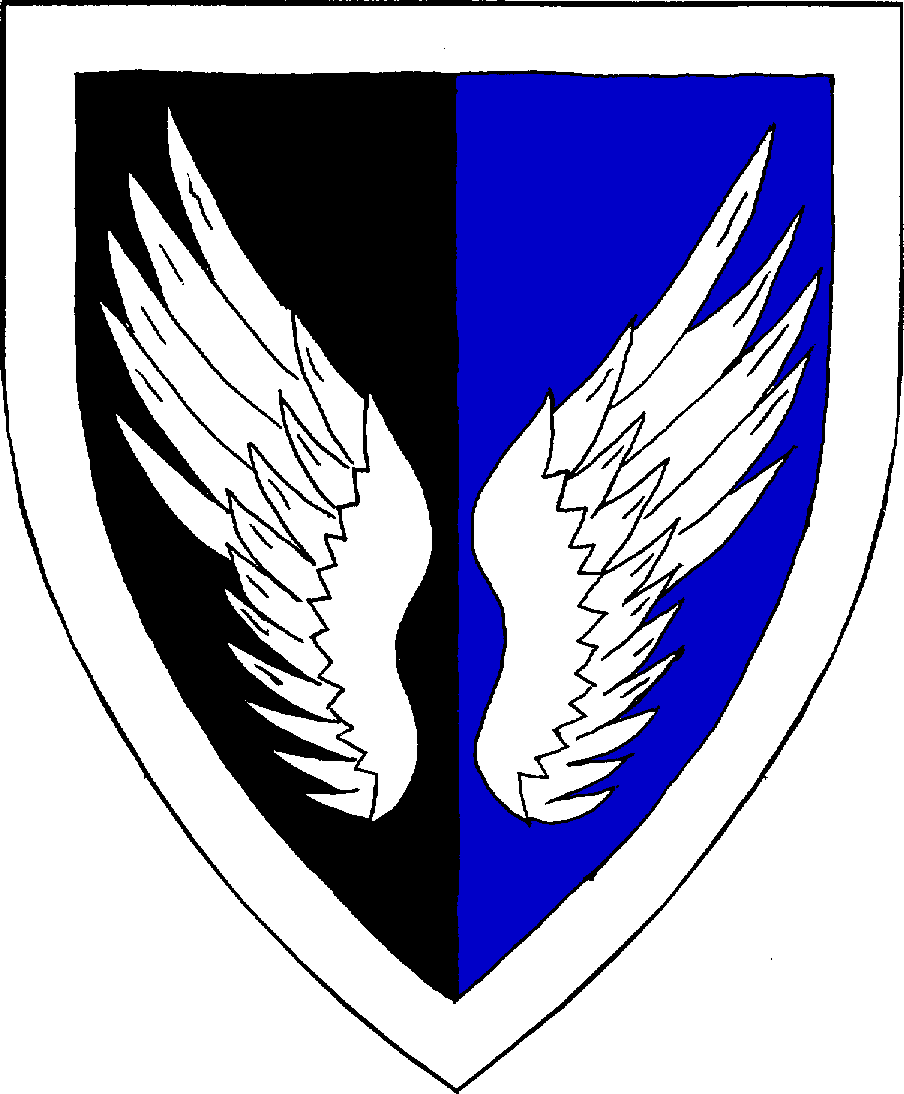
Device Resubmission to Laurel
Per pale sable and azure, a pair of wings and a bordure argent.
This name was registered in February 2001. A previous device, 'Per pale sable and azure, a dexter wing and a sinister wing argent' was returned by Laurel in June 2001 for conflict with 'Per chevron vert and argent, in chief two wings addorsed argent' [Francois le Féroce, Mar '84].
Adding a bordure to the previous design has cleared it of any conflicts (that we could find, at least).
New Name (see RETURNS for Device
The submittor desires a feminine Italian name meaning 'Katerina of Naples' (the name originally submitted), cares most about the language/culture, and will accept major changes.
Caterina: Josh Mittleman, 'Feminine Given Names from the Online Catasto of Florence of 1427' has this at the top of the list of names sorted by frequency.
Napoli: originally a Greek settlement, the city of Neapolis was conquered by the Romans in the 4th century BC, captured by the Byzantines in the 6th century AD, became an independent duchy in the 8th century, was captured by the Normans in 1139 and from 1282 was the capital of the kingdom of Naples (which existed until 1861).
According to this website, there was a princess of Naples called Caterina who was born in 1347 and died sometime after 1362. However, we don't believe this real 'Caterina of Naples' to have been important enough for us to protect and thus prevent registration of the submitted name.
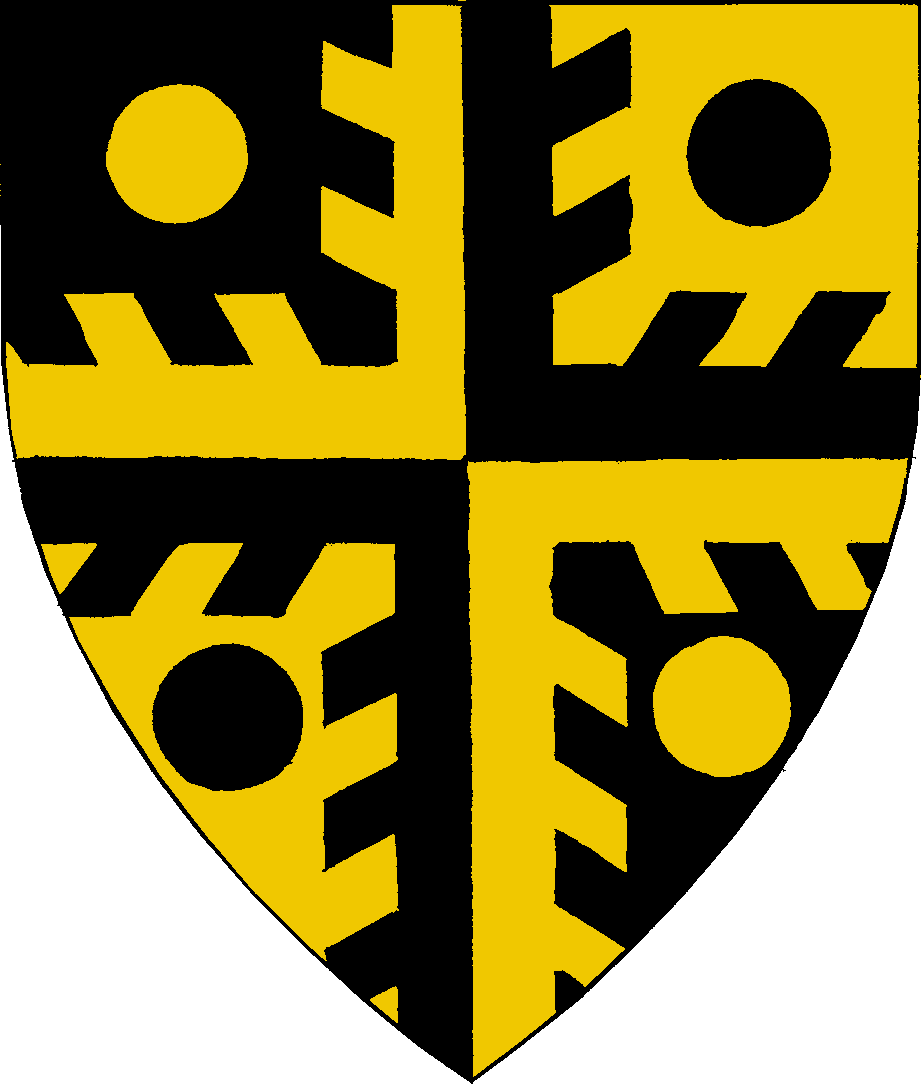
New Name and Device
Quarterly sable and Or, a cross raguly between four roundels all counterchanged.
The submittor desires a masculine 16th century French name and will accept major changes.
Mynjon: listed by Sarah Friedemann & Brian Scott, 'Names Found in Commercial Documents in Bordeaux, 1470-1520'.
du Jardin: Marie-Thérèse Morlet, 'Étude d'Anthroponymie Picarde' (p.359), has Guillot du Jardin from 1306.
There was much debate at the meeting, due to the amount of counterchanging used here, as to whether or not this device violated RfS VIII.3:
Armorial Identifiability - Elements must be used in a design so as to preserve their individual identifiability.
Certainly, designs have been previously returned by Laurel for excessive counterchanging, for instance:
{Quarterly,...an increscent within four mullets of four points in cross counterchanged} "The counterchanging of the primary and secondary charges is excessive, and reduces their identifiability to an unacceptable degree." (LoAR 12/91 p.17)
{Per saltire, a saltire cotised counterchanged} This is being returned per RFS VIII.3 for excessive counterchanging. (Rowan O Moroghoe, LoAR 10/96 p.8)
However, other designs featuring counterchanged crosses have been recently registered, including:
Quarterly sable and argent, a cross crosslet fitchy between four fleurs-de-lys counterchanged. [April 1999]
Quarterly Or and azure, a cross moline between four suns counterchanged. [April 1999]
Quarterly vert and argent, a cross bottony counterchanged, in chief a coronet Or. [March 1993]
Quarterly argent and sable, a cross counterchanged. [June 1998]
In this case, although the primary is accompanied by secondaries and also has a complex line of partition, the secondaries do not overlie the line of partition and the complex line is quite bold in outline (unlike cotises, for example). As it is something of a borderline case it is being sent up the line for the College of Arms and Laurel to make the final decision.
New Name (see RETURNS for Device
The submittor desires a feminine 14th century 'Anglo-French' name, cares most about the language/culture and will accept minor changes only. The name originally submitted was Thomasine l'Estrangier.
Thomasina: this spelling is dated to 1346 E.G. Withycombe, 'The Oxford Dictionary of English Christian Names', 3rd ed., s.n. Thomasin(e)]. No date is given for the version with a final 'e'.
l'Estranier: Marie-Thérèse Morlet, 'Étude d'Anthroponymie Picarde' (p.417), has Jehan l'Estranier from 1438, and also Jehenne l'Estrennere from 1324. The related English forms are Lestrange (1192), le Estrange (1199) and le Strange (1221). [Reaney, 2nd ed., s.n. Strange, et. al.]
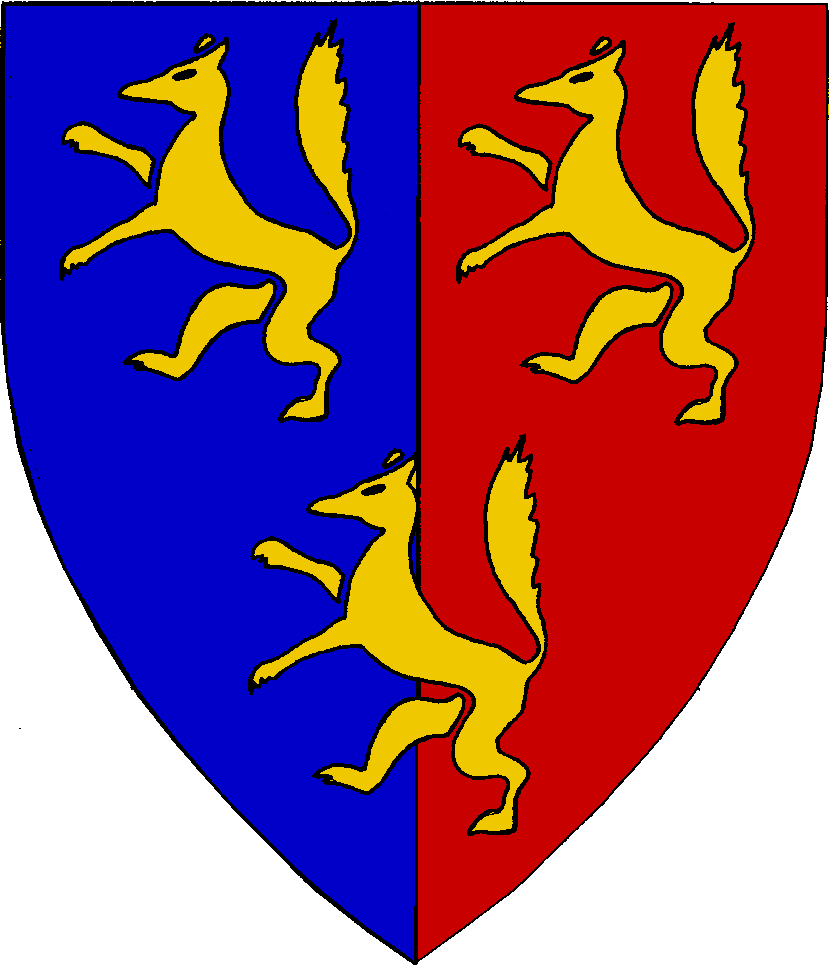
New Name and Device
Per pale azure and gules, three foxes Or.
The submittor desires a masculine 14th century name of unspecified (presumably English) origin and will accept major changes.
Wakeline: Reaney, 2nd ed, s.n. Wakelin, et. al., cites Wakelinus de Roking dated 1221. Joseph Foster, 'Feudal Coats of Arms', Senate 1995, has Wakeline de Arderne from the Edward III roll.
Foxley: Ekwall, 'The Concise Oxford Dictionary of English Placenames', 4th ed., has Foxle dated to 1086 and 1254. Joseph Foster, 'Feudal Coats of Arms', Senate 1995, has Sir John de Foxley from the Edward II roll
The following submissions were RETURNED in April 2002 for further work

New Name and Device
Argent goutty de larmes, a rose proper and a bordure azure.
The submittor desired a masculine name of unspecified origin, cared most about the sound and would accept major changes.
Unfortunately, neither the information provided, nor anything we at the meeting could find, was enough evidence to show that Baine was a name used by (or known to) pre-1600 Europeans.
The supplied documentation for Baine consisted of a printout from a website called "Saint O'the Day" which claimed that a Saint Bagnus of Calais who died circa 710 was also known as Bain or Bainus. The source of this claim was not cited in the article, nor could we find any more information elsewhere to verify it (this Saint Bagnus being a somewhat obscure saint).
A further problem was that Bagnus could be documented only to the 8th century and Stornoway (a place somewhere in Scotland) to the 16th century. Laurel has previously returned names that have elements so temporally distant, especially when they are also from different cultures.
The device appears free from problems, but cannot be registered without a name.

New Device
Per pale embattled vert and purpure, a compass star argent.
This conflicts with 'Per chevron argent and vert, in base a mullet of four points argent' [device, Andrew Greencloak Hethilsson, Aug 1986]; 'Azure, a riven star argent' [badge, Barony of Rivenstar, Aug 1979] and 'Per bend sinister, per bend argent and sable, and purpure, a compass star of four points argent' [device, Eleazar Valentine von Mindelheim, Jan 1980].
In each case there is one CD for changes to the field, but there is no significant difference between a compass star, a riven star, a mullet of four points or a compass star of four points.
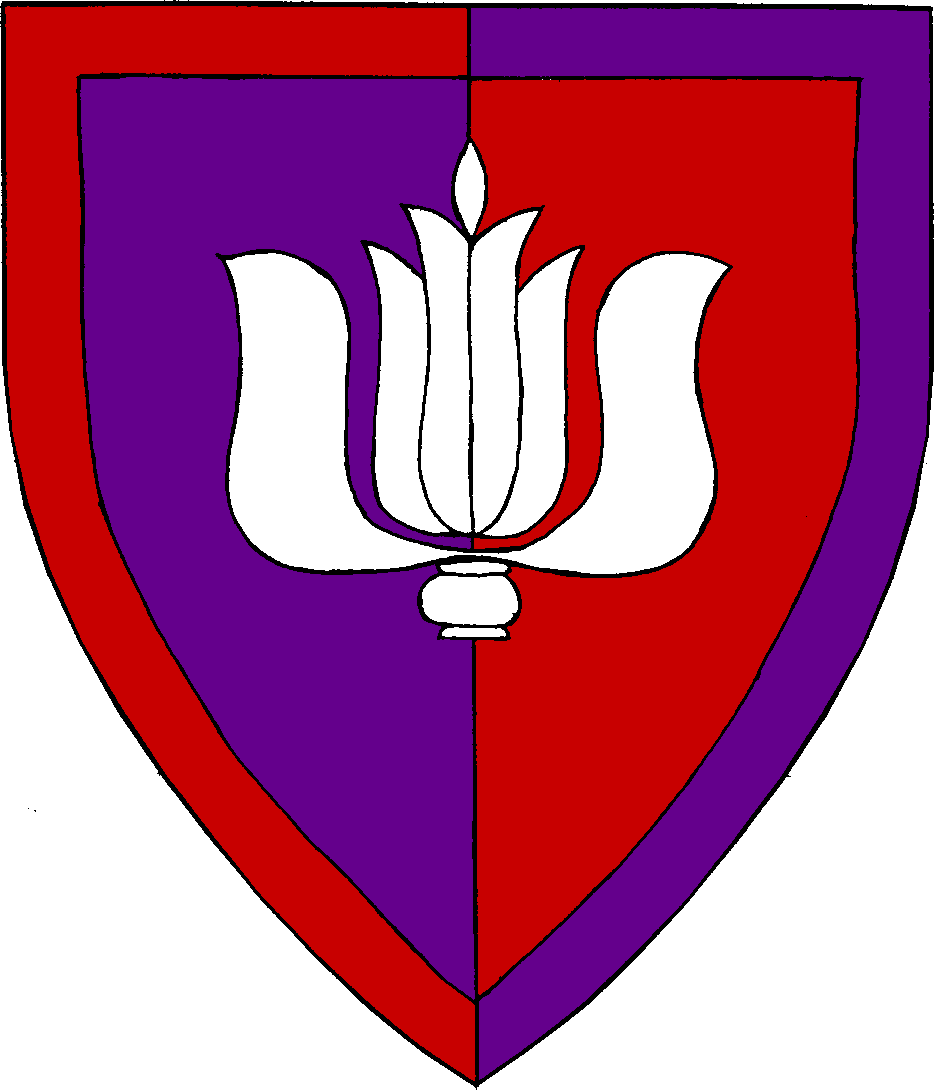
New Device
Per pale purpure and gules, a gendy flower argent and a bordure counterchanged.
The bordure on this device is 'colour on colour' and must therefore be returned for breaking VIII.2 of the RfS:
Armorial Contrast. - All armory must have sufficient contrast to allow each element of the design to be clearly identifiable at a distance.
It is also being returned for violation of VII.7.a of the RfS:
Identification Requirement - Elements must be recognisable solely from their appearance. Any charge, line of partition, or field treatment used in Society armory must be identifiable, in and of itself, without labels or excessive explanation. Elements not used in period armory may be defined and accepted for Society use if they are readily distinguishable from elements that are already in use.
In this case, the primary charge is an SCA invention that has only ever been registered once before (in a device for Alma Tea av de Telemark in August 1979). None of us at the meeting could identify the charge from the emblazon alone, with some thinking it was a kind of brazier.
Crux rant of the month. This charge was undoubtedly taken from 'A Pictorial Dictionary of Heraldry as used in the SCA'. Although this tome is a wonderful resource for scribes and heralds, its use for consulting is greatly discouraged.
The reason for this is that it contains a number of non-period and SCA-invented charges which are (or should be, in my opinion) no longer accepted for registration, as well as some (such us the fylfot) which have never been allowed.
It is far preferable to show submittors examples of real medieval heraldry. Most decent heraldry books will have a few photographs of medieval rolls of arms, and Joseph Foster's 'The Dictionary of Heraldry' (or even better, his 'Feudal Coats of Arms') are drawn almost exclusively from medieval rolls.
If you must use the 'Pic Dic', at least explain its shortcomings to the submittor, and don't be afraid to say "I don't think you can use that - let me check with Crux first". End of rant.
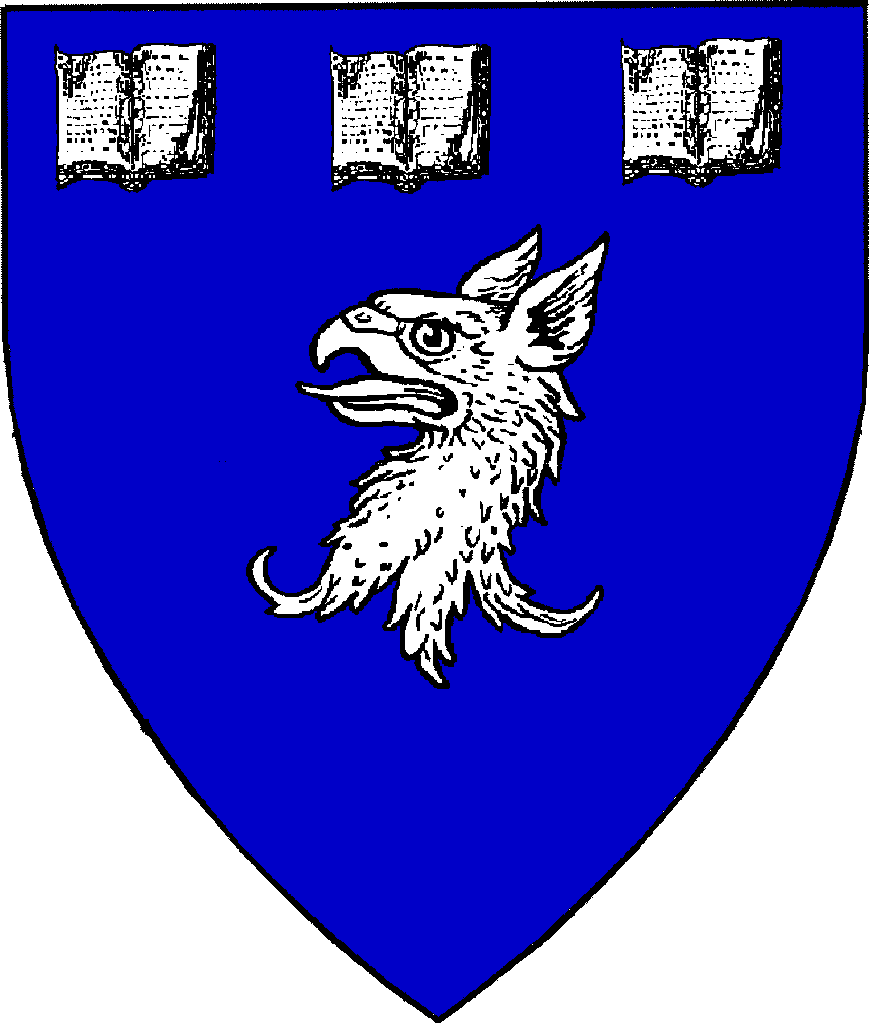
New Device
Azure, a griffin's head and in chief three open books argent.
This is in conflict with 'Azure, a bald eagle's head erased, issuing flames from the beak and the line of erasure, all proper' [device, Elrhond Windrider, Nov 1977]. There is a CD for the addition of the books, but none for the changes to the primary charge (a bald eagle's head is argent by default).
Turning the head to face sinister would also result in a conflict, this time with 'Azure, a falcon's head couped reversed argent' [badge, John the Rhymer, Mar 1978].
The following submission was PENDED:
Branch Name Resubmission to Crux Australis
This submission was actually considered at the March 2002 meeting, but I neglected to make time to actually write to the group informing them of the decision (naughty Crux, slap on wrist for you!).
Their previous branch name submission was returned by me in August 2001 for non-period formation of the placename. In this resubmission they have attempted to show that names of the style "X's Town" were used in period and that therefore "Hunter's Isle" follows period naming styles.
Sadly, the argument they use (based on websites of dubious authority for placenames) was not strong enough to convince us, especially when the overwhelming evidence from more reliable sources is the opposite.
As a contingency plan, they also requested that the name Isla de Cazador be considered should their original submission be unacceptable. Although a large amount of documentation was provided, it was not arranged in a way that made it easy for us to find the relevant portions that would allow us to support their submission. (It was not helped by the fact that the third page of the cover letter, which presumably explained the documentation, was missing.)
Only one of the three sources used had a photocopy of the title page provided, and also appeared to be the only work of any real value here (the others being an examination of the Navigatio Sancti Brendani Abbatis, and Donald S. Johnson's Phantom Islands of the Atlantic - both interesting, but only partially useful).
The submission has been pended to allow the group to consult further and gather better evidence before resubmitting.
Lochac submissions from the January 2002 Letter of Acceptances and Returns (dated March 23, 2002):
REGISTERED
Ælfred {th}e Lef. Name.This name is registerable as a mix of Old English and Middle English. It would be more authentic in a fully Old English form (Ælfred se leof) or a fully Middle English form (Alfred {th}e Lef).Artemisia da Quieto d'Arzenta. Device. Purpure, a bend sinister ermine between two compass stars argent.
[Note: {th} represents the thorn character which not all browsers can display]Please advise the submitter that the ermine spots on the bend would have been drawn bendwise in period, rather than palewise as depicted here. Maister Iago ab Adam, who has been doing research into furs in heraldry and heraldic art, has provided some useful information which is summarised here.
There seem to be few ermine bends in period, but they may be found throughout the heraldic period. Those which he found are all depicted with the ermine spots tilted bendwise on the bend. The analogous design of ermine fretty usually tilts the ermine spots. Ermine spots on other ordinaries incorporating diagonal portions, such as chevrons, saltires and bordures, are generally drawn palewise. However, sometimes one finds the spots on the diagonal portions of these charges tilted bendwise or bendwise sinister to follow that portion of the ordinary, apparently as a matter of artist's license. In short, they act much like a group of compact tertiary charges (such as mullets or escallops) when placed on an ordinary.
Ermine spots which are part of an ermine tincture are not charges but are part of a tincture. There does not seem to be any sort of distinct period tincture of ermine palewise or ermine bendwise and we are disinclined to introduce such a concept into SCA heraldry without supporting documentation. By contrast, charges are explicitly found in different orientations (such as bendwise or palewise) in period. As a result, if a bend ermine is drawn with palewise spots, we will blazon it simply as ermine and instruct the submitter to draw the fur in a more period fashion. However, if a bend is charged with palewise charges, they will continue to be explicitly blazoned as palewise.
RETURNED
None.